In-Sight Publishing
Born to do Math 18 - Choices in Worlds
Born to do Math 18 - Choices in Worlds
Scott Douglas
Jacobsen & Rick Rosner
March 25,
2017
[Beginning of recorded material]
Rick Rosner: The
universe - reflects what has clustered together and how it’s clustered together
reflects – if you want to look at this way choices among multiple possible
worlds, which isn’t a really helpful way of looking at it. The universe
could’ve clustered in any number of ways. Maybe, anomalies in density. Maybe,
different parts of the universe getting hit with photons more than other parts
based on light emitting bodies like stars.
Things are pushed into clusters, collapse into
clusters. The cluster you have 10^80th or so atoms in the universe.
You have 10^58th stars or so in the universe. You a have 10^11th
galaxies. At some point, there was some choice within a galaxy, say, about how
exactly its matter and its 10^11th stars will be divvied up, whether
molecule A or hydrogen atom A was going to end up falling into a dust cloud
that would form this star.;
Or whether that hydrogen atom falls into
another cloud that will condense into another star. There’s some choice in that
clustering contains information. By just saying that, it doesn’t tell you that
much. It’s also a good bet that memory in the universe—that the universe is
able to store information by moving large structures to the outskirts of the
universe where the time moves more slowly.
Close to an apparent T=0, there’s less
interaction and things are frozen in a relativistic sense because time is
dilated and there may be ways to do that time dilation thing within galaxies
via gravitationally collapsed object. It may be able to hold onto stuff until
its needed by tossing it into a black hole. But the whole idea of the universe
understanding itself, the universe containing the information it contains runs
into the problem of anthropomorphization.
We see things because we receive perceptual
information through our senses and then we process it through thought and brain
cells that are connected in such a way that they clarify what we’re seeing,
which is sub-thought. And memory and various expert subsystems that provides
various interpretations and clarifications about what we see. And we’re highly
evolved beings with highly evolved toolkits in our brains. And if we say the
universe is made of information, the universe has to understand that
information, but there are no mechanisms along the lines of what we have in our
brains for the brain to understand itself in any way that might be familiar to
us.
Because the universe consists of chaotically
boiling stars and swirling galaxies, and it’s not an evolved brain. It doesn’t
have evolved structures for thinking. |Yet we’re still claiming that it is made
of information, and thanks to the physics of the universe the universe is able
to share information with itself and able to maintain order. So that sets out
the problem: Where is the information? How does the universe understand it? How
does the universe process t?
All without evolved structures for that.
[End of recorded material]
Authors[1]

Rick Rosner
American Television Writer
RickRosner@Hotmail.Com
Rick Rosner

Scott Douglas Jacobsen
Editor-in-Chief, In-Sight Publishing
Scott.D.Jacobsen@Gmail.Com
In-Sight Publishing
Endnotes
[1] Four format points for the session article:- Bold text following “Scott Douglas Jacobsen:” or “Jacobsen:” is Scott Douglas Jacobsen & non-bold text following “Rick Rosner:” or “Rosner:” is Rick Rosner.
- Session article conducted, transcribed, edited, formatted, and published by Scott.
- Footnotes & in-text citations in the interview & references after the interview.
- This session article has been edited for clarity and readability.
- American Psychological Association. (2010). Citation Guide: APA. Retrieved from http://www.lib.sfu.ca/system/files/28281/APA6CitationGuideSFUv3.pdf.
- Humble, A. (n.d.). Guide to Transcribing. Retrieved from http://www.msvu.ca/site/media/msvu/Transcription%20Guide.pdf.
License
In-Sight Publishing and In-Sight: Independent Interview-Based Journal by Scott Douglas Jacobsen is licensed under a Creative Commons Attribution-NonCommercial-NoDerivatives 4.0 International License.
Based on a work at www.in-sightjournal.com and www.rickrosner.org.
Copyright
© Scott Douglas Jacobsen, Rick Rosner, and In-Sight Publishing and In-Sight: Independent Interview-Based Journal 2012-2017. Unauthorized use and/or duplication of this material without express and written permission from this site’s author and/or owner is strictly prohibited. Excerpts and links may be used, provided that full and clear credit is given to Scott Douglas Jacobsen, Rick Rosner, and In-Sight Publishing and In-Sight: Independent Interview-Based Journal with appropriate and specific direction to the original content.
No comments:
Post a Comment